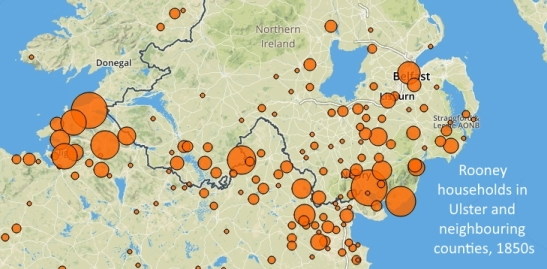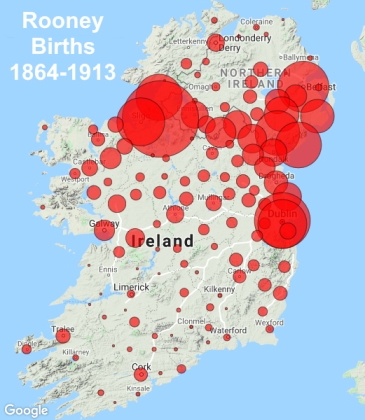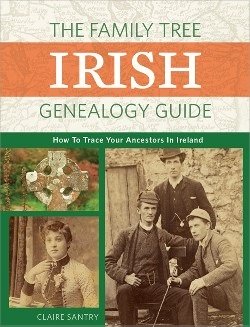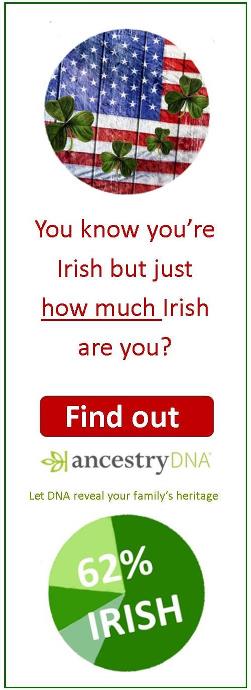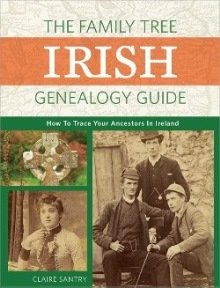- Home ›
- Irish Census ›
- Rooney
Irish surname Rooney - the name of a champion
Rooney is the anglicised version of 'O Ruanaidh', from Ruanaidh, a Gaelic first name meaning "champion". The prefix 'O' tells you the bearer of the name is a 'descendent of a champion', but exactly which champion, and where his skills lay, is lost to history.
The principal family of the name originated in County Down, where their territory was centred on the parish of Ballyroney (click for map), which lies on the north-eastern bank of the Upper River Bann between Dromara and Rathfriland.
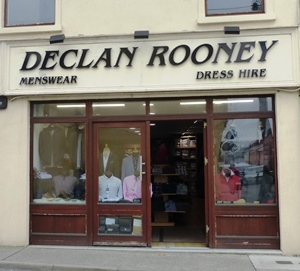 Declan Rooney Menswear store in the centre of Athenry, Co Galway.
Declan Rooney Menswear store in the centre of Athenry, Co Galway.Bally is a common prefix to town names in Ireland, and is derived from the Gaelic phrase 'Baile na', meaning 'place of'.
Although this Irish surname was originally O'Rooney, the prefix 'O' (meaning descendent of) was dropped between the 17th and mid-late 19th centuries.
This was fairly common during the long years of religious intolerance and penal laws but while most 'O' surnames reattached their prefix in the late 19th and early 20th centuries, Rooney families chose not to follow suit.
 Declan Rooney Menswear store in the centre of Athenry, Co Galway.
Declan Rooney Menswear store in the centre of Athenry, Co Galway.The principal family of the name originated in County Down, where their territory was centred on the parish of Ballyroney (click for map), which lies on the north-east bank of the Upper River Bann between Dromara and Rathfriland.
Bally is a common prefix to town names in Ireland, and is derived from the Gaelic phrase 'Baile na', meaning 'place of'.
Although this Irish surname was originally O'Rooney, the prefix 'O' (meaning descendent of) was dropped between the 17th and mid-late 19th centuries.
This
was fairly common during the long years of religious intolerance and penal laws
but while most 'O' surnames reattached their prefix in the late 19th and early
20th centuries, Rooney families chose not to follow suit.
While the Irish surname Rooney appears in most parts of the island, it isn't common in the province of Munster. It remains most prevalent in its traditional homelands of County Down, and in Fermanagh and northern Connacht, where the name is thought to have evolved from Mulrooney. This latter name comes from O Maolrunaidh, meaning 'servant of Ruanaidh', and its largest grouping was found in the north-western reaches of County Leitrim and neighbouring coastal areas of Counties Sligo and Donegal.
In the 1850s, an island-wide survey of land and property known as Griffith's Valuation recorded 1,145 Rooney housholds, 120 Mulrooneys, 93 Roneys and a trio of alternative spellings - Roony, Roonoe, Roone - adding 20 more households.
County Down had the largest single group of Rooneys (200 households), Leitrim and Sligo the second and third biggest (105 and 103 respectively), followed by Monaghan (65), Fermanagh (63), Louth (59), Meath (57) and Dublin City (47).
The single largest group of Mulrooneys was in County Kilkenny, with 41 Mulrooney households (34% of the total), followed by Galway (15), Carlow (12), Mayo (12). Other counties recorded single figures.
Looking just at the more prevalent Rooney surname, this same geographical mix appears loud and clear from the registrations of births spanning 1864-1913.
The Irish surname Rooney beyond Ireland
In the 1850s, there were about 8,000 individuals with the family name Rooney in Ireland. Censuses taken in countries beyond these shores in the early 1860s turn up a further 4,500.
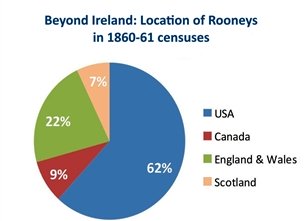
Not surprisingly, the USA was the chosen home for most of these migrants, and their numbers grew dramatically in the following years, reaching 10,285 in 1930 and 16,823 in 2010.
Rather less expected was relative reluctance of these Rooney immigrants from Ireland to settle far from the north-eastern states.
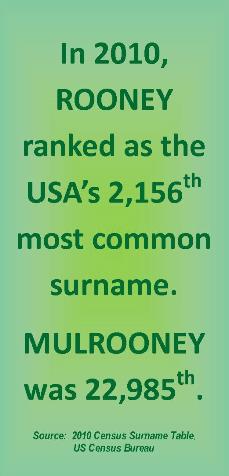
In 1880, more than 60% of the 5,331 families with this name in the US lived in New York, Pennsylvania, New Jersey, Connecticut and Vermont and half of these lived in New York alone.
Forty years later, this preference was even more pronounced, with 66% of Rooney families in these same states. By this time, however, the surname was represented in all states except North Carolina. You can learn more by playing with Ancestry.com's interactive map.
The same map is especially useful for tracing the locations of Rooney families in Scotland as they moved about the country. In 1841, there were just 46 individuals with this surname in Scotland.
The oldest of them was an Irish-born John Rooney who lived with his 55-year-old wife Mary in North Street, Barony, in Lanark parish. John gave his year of birth as 1766.
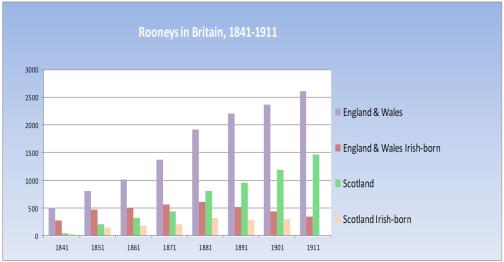 The map shows the number of Rooneys in Britain as enumerated in the decennial census. Data for Scotland in 1911 will be added in due course.
The map shows the number of Rooneys in Britain as enumerated in the decennial census. Data for Scotland in 1911 will be added in due course.In 1891, exactly half of the entire population of Rooneys in England and Wales lived in Lancashire. There was another cluster, albeit much smaller and accounting for only 9% of Rooney families, in London, while Cheshire, Warwickshire, Cumbria and Northumberland were collectively home to another 15%.
But no one could count a Rooney among their neighbours in 24 of the historical counties of England and Wales, including some of the largest (Yorkshire, County Durham, Westmoreland, Norfolk).

Not surprisingly, the USA was the chosen home of the largest proportion of these migrants, and their numbers grew dramatically in the following years, reaching 10,285 in 1930 and 16,823 in 2010.
What is surprising about the Rooney immigrants from Ireland is their relative reluctance to settle far from the north-eastern states. In 1880, more than 60% of the 5,331 families with this name in the US lived in New York, Pennsylvania, New Jersey, Connecticut and Vermont and half of these lived in New York alone.
Forty years later, this
preference was even more pronounced, with 66 of Rooney families in these
same states. By this time, however, the surname was represented in all
states except North Carolina. You can learn more by playing with Ancestry.com's interactive map.

The same map is especially useful for tracing the locations of Rooney families in Scotland as they moved about the country. In 1841, there were just 46 individuals with this surname in Scotland. The oldest of them was an Irish-born John Rooney who lived with his 55-year-old wife Mary in North Street, Barony, in Lanark parish. John gave his year of birth as 1766.
 The map shows the number of Rooneys in Britain as enumerated in the decennial census. Data for Scotland in 1911 will be added in due course.
The map shows the number of Rooneys in Britain as enumerated in the decennial census. Data for Scotland in 1911 will be added in due course.In 1891, exactly half of the entire population of Rooneys in England and Wales lived in Lancashire. There was another cluster, albeit much smaller and accounting for only 9% of Rooney families, in London, while Cheshire, Warwickshire, Cumbria and Northumberland were collectively home to another 15%.
But no one could count a Rooney among their neighbours in 24 of the historical counties of England and Wales, including some of the largest (Yorkshire, County Durham, Westmoreland, Norfolk).
Rooney's Island (Oileán Uí Ruanaí)
This small, uninhabited island of just 36 acres lies in the estuary of the River Eske in Donegal (Town) Bay. It is surrounded by the cold waters of the Atlantic at high tide. See it's location on Mindat.org.
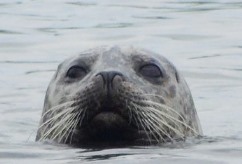
Donegal Bay Waterbus offers an 80-minute tour of the Bay including a colony of about 200 Habour or Common grey seals on Seal Island, a little to the south of Rooney's Island.
Varients of Rooney
In the 1850s, an island-wide survey of land and property known as Griffith's Valuation recorded 1,145 Rooney housholds, 120 Mulrooneys, 93 Roneys and a trio of alternative spellings - Roony, Roonoe, Roone - added 20 more households.
The Family Tree Irish Genealogy Guide
Written by the creator of Irish Genealogy Toolkit and Irish Genealogy News, 'The Family Tree Irish Genealogy Guide' is full of advice, tips and strategies to ease what can be a challenging journey.
Its guidance will be useful to any researcher of Irish heritage, but especially for the target Irish-American researcher who's struggling to work back to Ireland from their immigrant ancestor.
Publisher: Penguin
ISBN: 9781440348808 / 240 pages.
